Microsoft Surface Pro Review
by Anand Lal Shimpi on February 5, 2013 9:00 PM ESTSurface Pro as a Tablet
If you can get over the bulk, Surface Pro is easily the fastest tablet on the market today. Apple has done a great job of making relatively slow hardware feel very fast with iOS, but Surface Pro brute forces its way to the top. Web pages load quicker than on any ARM based tablet and multitasking is just awesome on the device. This is where the power of Intel’s Core microarchitecture really comes into play.
Since the introduction of the 3rd generation iPad with Retina Display several folks have pointed out to me that UI frame rate isn’t always so smooth on the device. I personally never noticed because I found that most of the competition was even worse, so it always seemed relatively smooth to me. After playing with Surface Pro however and going back to even the 4th gen iPad all of the sudden frame rate stutters are much more noticeable. Playing around with Bing maps on Surface Pro vs. RT is like night and day. Even if you compare scrolling and zoom performance to native iOS maps on the iPad 4, Surface Pro wins out.
Scrolling in web pages, application install time, file copy time, everything is just significantly faster on Surface Pro than on any competing tablet. Oh, and it boots (from full power off) in less than 10 seconds. It’s really the combination of the great CPU performance and fast SSD that deliver the responsiveness of the Surface Pro.
We’re still lacking good cross-platform performance tests, but there are a few browser based benchmarks that I can use to highlight just how much faster Surface Pro is compared to anything ARM based on the market today:
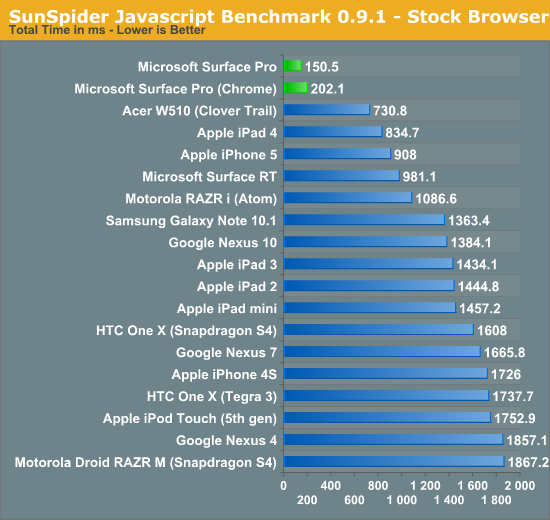
SunSpider is our tried and true quick js benchmark, and here we see huge scaling as we move to Intel's Core i5. Regardless of browser used you're seeing a significant improvement in performance that directly translates to faster web page load times.
Moving on we have Kraken, a seriously heavy javascript benchmark built by Mozilla. Kraken focuses on forward looking applications that are potentially too slow to run in modern browsers today. The result is much longer run times than anything we've seen thus far, and a very CPU heavy benchmark:
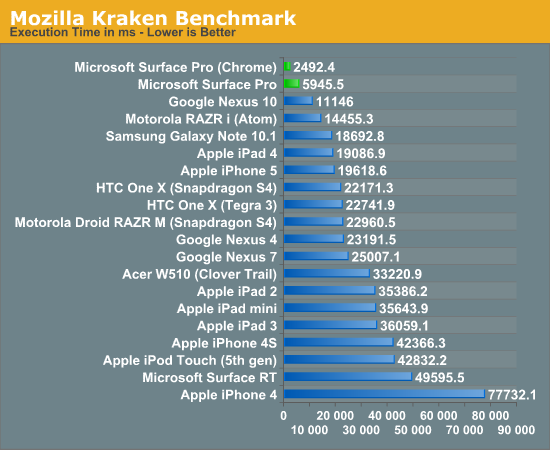
Even when handcuffed by modern IE10 you're looking at almost twice the performance of the Nexus 10. Level the playing field with Chrome as a browser and now Surface Pro completes the test in a bit more than 1/8 of the time of the iPad 4, or 1/4 of the time of the Nexus 10.
Surface Pro manages to deliver almost 5x the performance of the iPad 4 here.
We have one last web-based benchmark: WebXPRT by Principled Technologies (PT). WebXPRT measures performance in four HTML5/js workloads:
Photo Effects: Measures the time to apply effects to a set of six photos. The filters are Sharpen, Emboss, and Glow. WebXPRT applies each filter to two photos. This test uses HTML5 Canvas 2D and JavaScript.
Face Detect: Measures the average time to check for human faces in a photo. WebXPRT runs this test on five photos and uses the average time to calculate the final result. This test uses HTML5 Canvas 2D to get access to photo data. The detection algorithm is implemented in JavaScript.
Stocks Dashboard: Measures the time to calculate financial indicators of a stock based on historical data and display the result in a dashboard. The calculations are done in JavaScript, and the calculated stocks data is displayed using HTML tables and Canvas 2D.
Offline Notes: Measures the time to store notes securely in the browser's HTML5 local storage and display recent entries. This test uses using AES for security.
We're reporting the overall score after all tests have been run:
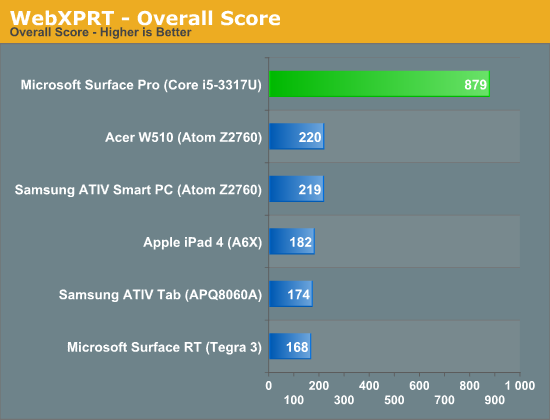
Next up are another set of benchmarks from PT, but unlike the WebXPRT suite these tests don't run in a browser. Once again we're looking at performance in a handful of tasks designed to stress the CPU. Here the performance advantage continues to be quite significant. While Surface RT and the other Windows RT/8 devices still feel a bit sluggish, I have no performance complaints whatsoever about Surface Pro:

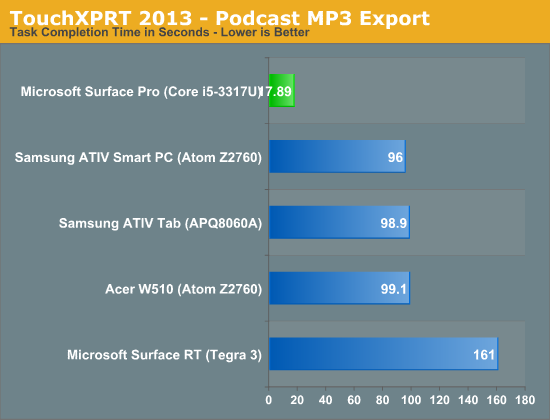
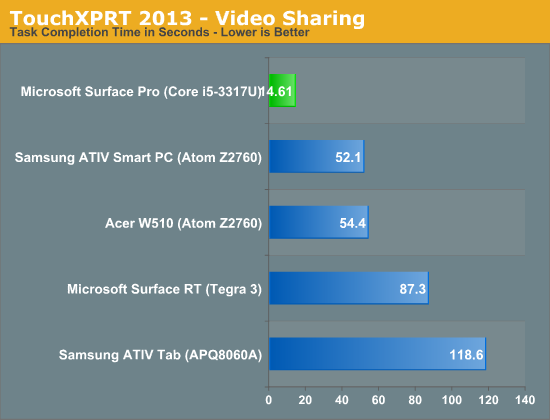
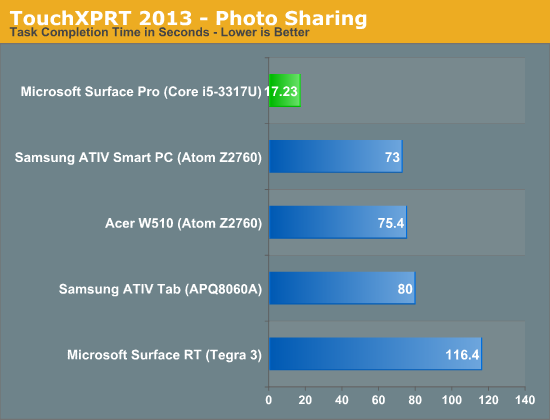
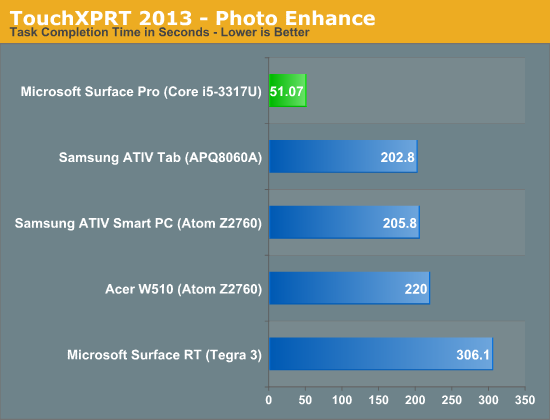
If I had any complaints about using Surface Pro as a tablet outside of weight, they’d be about Windows 8. There are still far too many bugs and quirks in the OS that just don’t make sense. I’ve outlined some of my issues with Windows 8 before. I think the UI works just fine for a tablet, it’s just the unfinished touches that need attention. For example, having to gesture in modern IE10 before being able to switch between tabs seems silly.

This still happens way too often in the Windows Store, no indication of what's going on just a blank screen
On the bug-front, all too often I’ll wake up the system only to have the lock screen upside down. And despite all of the extra performance under the hood, the time from when you hit the power/lock button to when something appears on the screen is just longer than on an iPad or Android tablet. We’re not talking several seconds, but it’s still noticeably longer.










228 Comments
View All Comments
powerarmour - Thursday, February 7, 2013 - link
x86 compatibility isn't a deal breaker at all, not any more.Even Microsoft are pushing for cross compatible RT apps. And there is a huge amount of software out there already for Android and iOS.
oolzie - Wednesday, February 6, 2013 - link
I do think you should revise it to point out that you can and are probably expected to use the stylus when using desktop apps without a kb/m combo or cover. I haven't used the Pro yet, but I have used another Win8 tab with stylus and using the stylus as a finger removed nearly all of the frustration of desktop navigation in tablet mode.Jhlot - Wednesday, February 6, 2013 - link
If this thing had a a dock connector/stand for when business types are at the office it would be the killer business PC to have and they would move a ton a units to big corporations. I cannot believe Microsoft failed to include a docking solution.....huge miss MS, failure of imagination and to really innovate competitively.andrewaggb - Thursday, February 7, 2013 - link
I totally agree. And sure the dock/device can run 2 external displays (even if you have to disable the built in one).And next time support WIDI.
andrewaggb - Monday, February 11, 2013 - link
well, I discovered thesehttp://www.displaylink.com/shop/docks
USB 3 docks with dual monitor connectors (different vendors have different combinations including vga,displayport,hdmi,displayport)
Also have built in audio, usb hub, and gigabit ethernet. Some reviews seem ok. Not awesome for video and gaming (though they say it's ok), but sounds like it would be totally fine for work related tasks and you can use the tablets internet or external display for video and gaming if necessary.
So I guess I can scratch the no dock/multi-display issues off my issues list. And now I'm seriously considering it again.
eg
HP 3005pr USB 3.0 Port Replicator
http://www.fujitsu.com/uk/products/computing/pc/ac...
andykins - Wednesday, February 6, 2013 - link
That core i5 costs $225. You can get a whole Nexus 7 for that and still have change left over. ARM SOC's cost like $30, tops? Not disagreeing with you but there's more to it.LetsGo - Wednesday, February 6, 2013 - link
"ARM Processor inefficient compared to Intel's Core architecture.?"What planet do you live on, ARM processors have enabled normal people to enjoy computing, Intel would have never enabled this because the margins were not big enough for them.
When Arm gets its 64bit architecture on Intel is toast.
denman - Wednesday, February 6, 2013 - link
Great review! Really happy you paid more attention to screen and pen overview. Would you mind to post the calibration profile (file) somewhere?Imaginer - Wednesday, February 6, 2013 - link
That this thing is a boon for anyone that can draw, create, and do things with the pen. It has pressure sensitivity and by this review, also tilt. Sources elsewhere says it has an eraser and a right button click. I don't know about you but having a digitizer, touchscreen in a power of an ultrabook with the dual functionality of a tablet and a ultrabook? And under or around $1000? An intuos digitizer tablet easily eats $300 if not some. So all in all, you are all nay sayers and not seeing the true potential of this. This is never meant to be a simple toy.guidryp - Wednesday, February 6, 2013 - link
I like Anands Technical analysis of chip features.But when it comes to usability I really question positive reviews of this form factor that is neither that good as a tablet (Heavy, goofy 16:9 ratio, hot, heavy, weak battery life) and not that good as a laptop (cramped keyboard, small screen, awkward hinge/kicstand).